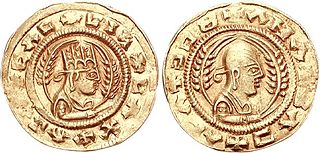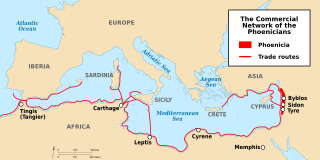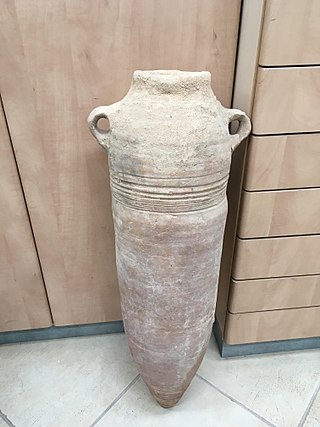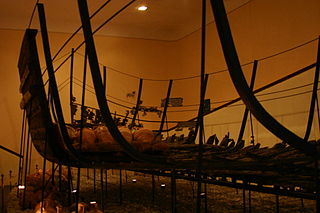
Maritime archaeology is a discipline within archaeology as a whole that specifically studies human interaction with the sea, lakes and rivers through the study of associated physical remains, be they vessels, shore-side facilities, port-related structures, cargoes, human remains and submerged landscapes. A specialty within maritime archaeology is nautical archaeology, which studies ship construction and use.

An amphora is a type of container with a pointed bottom and characteristic shape and size which fit tightly against each other in storage rooms and packages, tied together with rope and delivered by land or sea. The size and shape have been determined from at least as early as the Neolithic Period. Amphorae were used in vast numbers for the transport and storage of various products, both liquid and dry, but mostly for wine. They are most often ceramic, but examples in metals and other materials have been found. Versions of the amphorae were one of many shapes used in Ancient Greek vase painting.

The Uluburun Shipwreck is a Late Bronze Age shipwreck dated to the late 14th century BC, discovered close to the east shore of Uluburun, Turkey, in the Mediterranean Sea. The shipwreck was discovered in the summer of 1982 by Mehmed Çakir, a local sponge diver from Yalıkavak, a village near Bodrum.
The Institute of Nautical Archaeology (INA) is an organization devoted to the study of humanity's interaction with the sea through the practice of archaeology.

Bodrum Castle is a historical fortification located in southwest Turkey in the port city of Bodrum, built from 1402 onwards, by the Knights of St John as the Castle of St. Peter or Petronium. A transnational effort, it has four towers known as the English, French, German, and Italian towers, bearing the names of the nations responsible for their construction. The chapel was built around 1407 and the first walls completed in 1437. The castle started reconstruction in the late 14th century, only to be taken over by the Islamic Ottoman Empire in 1523. The chapel was converted to a mosque, and a minaret was added. The castle remained under the empire for almost 400 years. After remaining empty following World War I, in the early 1960s, the castle became the home for the Bodrum Museum of Underwater Archaeology. In 2016 it was inscribed in the UNESCO Tentative list of World Heritage Sites in Turkey.

Adulis was an ancient city along the Red Sea in the Gulf of Zula, about 40 kilometers (25 mi) south of Massawa. Its ruins lie within the modern Eritrean city of Zula. It was the emporium considered part of the D’mt and the Kingdom of Aksum. It was close to Greece and the Byzantine Empire, with its luxury goods and trade routes. Its location can be included in the area known to the ancient Egyptians as the Land of Punt, perhaps coinciding with the locality of Wddt, recorded in the geographical list of the Eighteenth Dynasty of Egypt.

The Kyrenia Ship is the wreck of a 4th-century BC ancient Greek merchant ship. It was discovered by Greek-Cypriot diving instructor Andreas Cariolou in November 1965 during a storm. Having lost the exact position, Cariolou carried out more than 200 dives until he re-discovered the wreck in 1967 close to Kyrenia (Keryneia) in Cyprus. Michael Katzev, a graduate student at the University of Pennsylvania Museum of Archaeology and Anthropology, directed a scientific excavation from 1967 to 1969. Katzev later became a co-founder of the American Institute of Nautical Archaeology. The find was extensively covered in a documentary by the Cyprus Broadcasting Corporation titled "With Captain, Sailors Three: The Ancient Ship of Kyrenia". The ship itself was very well preserved with more than half its hull timbers in good condition. After it was raised from the seabed, it found a new home at the Ancient Shipwreck Museum in Kyrenia Castle, where it remains on exhibit.

Ẓafār, also called Dhafar or Dhofar, is an ancient Himyarite site situated in Yemen, some 130 km south-south-east of today's capital, Sana'a, and c. 10 kilometres (6.2 mi) southeast of Yarim. Given mention in several ancient texts, there is little doubt about the pronunciation of the name. Despite the opinion of local patriots in Oman, this site in Yemen is far older than its namesake there. It lies in the Yemeni highlands at some 2800 m. Zafar was the capital of the Himyarites, which at its peak ruled most of the Arabian Peninsula. For 250 years the tribal confederacy and allies' combined territory extended past Riyadh to the north and the Euphrates to the north-east.

The Kingdom of Aksum also known as the Kingdom of Axum, or the Aksumite Empire, was a kingdom in East Africa and South Arabia from classical antiquity to the Middle Ages. Based in what is now northern Ethiopia and Eritrea, and spanning present-day Djibouti and Sudan, it extended at its height into much of South Arabia during the reign of Kaleb of Axum.
The Ayla-Axum amphorae are conical, carrot-shaped amphorae found around the Red Sea, particularly in the Late Roman/Byzantine period. Originally named after the widest range of finds in the Red Sea, subsequent findings since the mid-1990s indicate that the amphoras originate in Byzantine, or even early Islamic, Aqaba. Hence, the preferred nomenclature is now "Aqaba Amphora." The Aqaba amphora type has been found in many terrestrial sites throughout the region and beyond, such as in Eritrea and Ethiopia: Aksum, where amphora sherds with fabrics light red on the inside, pale gray on the outside, as well as greenish-gray fabric were found by the Deutsche Aksum Expedition ; Matara dating to the 4th through 7th centuries ; and Adulis examples of which are on display in the National Museum in Asmara. Other examples have been found at Berenike in Egypt, where the amphorae date to a circa AD 400 context in what may be the best-stratified examples ; from Aqaba in Jordan where many examples have been found, including their kilns; on The Shipwreck at Black Assarca Island, Eritrea ; and in the Mediterranean on the late 6th-century shipwreck at Iskandil Burnu, Turkey that is the sole example yet found in that sea. A number of the amphoras and sherds came to light during excavations at Zafar in Yemen, and eleven of the sherds were subjected to mineralogical analysis, which demonstrated that the amphoras originate in what is now Aqaba, Jordan.

The culture of the ancient Phoenicians was one of the first to have had a significant effect on the history of wine. Phoenicia was a civilization centered in current day Lebanon. Between 1550 BC and 300 BC, the Phoenicians developed a maritime trading culture that expanded their influence from the Levant to North Africa, the Greek Isles, Sicily, and the Iberian Peninsula. Through contact and trade, they spread not only their alphabet but also their knowledge of viticulture and winemaking, including the propagation of several ancestral varieties of the Vitis vinifera species of wine grapes.
Ancient Black Sea shipwrecks found in the Black Sea date to Antiquity. In 1976, Willard Bascom suggested that the deep, anoxic waters of the Black Sea might have preserved ships from antiquity because typical wood-devouring organisms could not survive there. At a depth of 150m, the Black Sea contains insufficient oxygen to support most familiar biological life forms.

The Ma'agan Michael Ship is a well-preserved 5th-century BCE boat discovered off the coast of Kibbutz Ma'agan Michael, Israel, in 1985. The ship was excavated and its timber immersed in preservation tanks at the University of Haifa, undergoing a seven-year process of impregnation by heated polyethylene glycol (PEG). In March 1999, the boat was reassembled and transferred to a dedicated wing built at the Hecht Museum, on the grounds of the university. The boat has provided researchers with insights into ancient methods of shipbuilding and the evolution of anchors.

Yassi Ada is an island off the coast of Bodrum, Turkey. This area of the Mediterranean Sea is prone to strong winds, making a safe journey around the island difficult. The island could be called a ships' graveyard, on account of the number of wrecked ships off its southeastern tip. Three wreck sites have been excavated under the direction of George Bass of Texas A&M University. The first to be studied using archaeological techniques was a 4th-century Byzantine wreck, the second a 7th-century Byzantine wreck, and the third a 16th-century Ottoman wreck. Bass received funding for a summer excavation at the site from the University Museum of the University of Pennsylvania and the National Geographic Society.
The Oxford Centre for Maritime Archaeology (OCMA) is a specialist research group within the School of Archaeology at the University of Oxford in England.
Ralph K. Pedersen is a nautical archaeologist from Levittown New York, United States. He was the DAAD Gastdozent für Nautische Archäologie at Philipps-Universität Marburg 2010–2013, and has been the "Distinguished Visiting Professor in Anthropology" and Knapp Chair in Liberal Arts at the University of San Diego, and the Whittlesey Chair Visiting Assistant Professor in the department of history and archaeology at the American University of Beirut. He has been teaching online courses in archaeology in the History Department at Nelson University since 2009.

The Peristera shipwreck is an underwater shipwreck of a 5th-century BC merchant vessel at a depth of 20 metres (66 ft), just off the islet of Peristera near Alonissos. Its cargo of 3000-4000 amphoras made it the largest transport ship yet known of its period when excavation began in 1992, and it carried wine from Mende and Skopelos. In addition to amphoras, the ship transported many valuable items including black-glazed cups, plates and bronze tableware. The site was opened to the public for scuba diving visits as the Alonissos Underwater Museum in 2020, the first such underwater museum in Greece.
Molyvoti is an archaeological site located on a peninsula in Northern Greece southwest of Komotini.

The Gaza Jar, Type 2, possibly identical to the Ashkelon Jar (askalônion), was a storage vessel used from the Roman period to the end of the Byzantine period and the beginning of the early Muslim period in the Holy Land. Gaza was a regional trading hub at this time. The jar was made on a potter's wheel and is believed to have been used to store vinum Gazetum, Latin for Gaza wine, a sweet wine greatly prized in Roman times which reached peak production in the early 6th century.

The Serçe Limani Shipwreck or Glass Shipwreck is a shipwreck discovered in the Serçe Limani bay, southwest coast of Turkey, opposing Rhodes, in the Mediterranean Sea. The shipwreck was discovered by Donald Frey during an individual dive.














